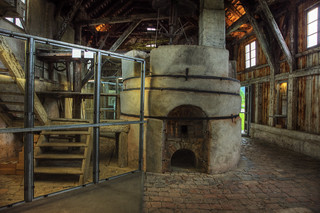Optical glass

|
| Fraunhofers vintage optical glass factory image by Robert Fosbury (Image rights) |
Optical glass must be bubble-free and must have a constant refractive index and constant chromatic dispersion. All kinds of glass to make lens elements, pentaprisms, matte screens, mirrors and maybe even fiber optics are special optical glass sorts. Most optical systems like lenses are made of more than one optical element. When several glass elements are combined it may be useful to use elements made of different glass sorts because the glass variants' different refractive indexes ease the construction of optimized optical systems.
The most common glass variants for making lens elements are
Crown glass
- sample recipe (German Wikipedia):
- quartz (SiO2): ca. 73 %
- sodium oxide (Na2O): ca. 5 %
- potassium oxide (K2O): ca. 17 %
- calcium oxide (CaO): ca. 3 %
- aluminium oxide (Al2O3): ca. 2 %
- refractive index: 1.5 to 1.6
and
Flint glass
- sample recipe (German Wikipedia):
- quartz (SiO2): ca. 62 %
- sodium oxide (Na2O): ca. 6 %
- potassium oxide (K2O): ca. 8 %
- lead oxide (PbO): ca. 24 %
- refractive index: 1.5 to 2.0
- variants: depending on lead contents: light flint, flint and heavy flint, modern variants with lead part substituted but lower refractive index
The chromatic dispersion is another characteristic of a glass sort, its degree is defined as the Abbe number. Optical flint glass has an Abbe number smaller 50, optical crown glass an Abbe number of ca. 60. The different characteristics of the optical glass sorts make it possible to minimize several typical lens faults by combining lens elements made of flint glass with elements made of crown glass.